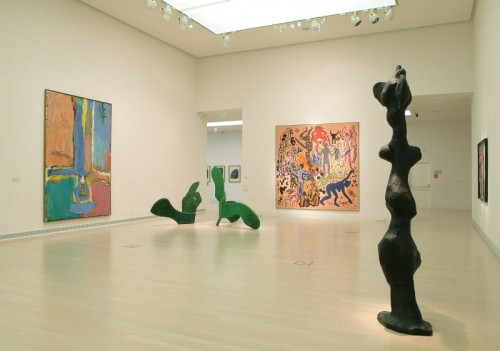Professor Dr Irene Ludwig is about to donate a painting of great value by Sigmar Polke to the Ludwig Museum Budapest. One of the founders of the Ludwig Foundation of Aachen , and that of the Ludwig Museum Budapest, announced she intends to contribute yet another piece to the collection on the occasion of the ribbon-cutting ceremony of the new building of the Ludwig Museum of Contemporary Art on March 14 this year. The picture will be received by Katalin Néray at an exclusive ceremony on September 13.
Sigmar Polke, born in 1941, lives in Cologne and is one of the most well known and most remarkable painters of present-day Germany. He was one of the founders of the so called „capitalist realism” (or that of European pop art in essence). His characteristic „dotted” style, by which he divides the picture into rasters and layers, into abstract patterns without any particular meaning, was inspired by commercial printing techniques. Instead of canvas he starts using textile manufactured in large-scale production, the patterns of which he incorporates into his paintings. In the 1970s photography influences his art to a great extent. In the 1980s he experiments with paint and chemical substances and produces abstract paintings as a consequence. He paints so called „allegorical historic paintings”, filled with political, cultural, and painterly references, in the last two decades.
His brand new painting, Untitled, 2005, that is to be transferred to the museum, is representative of this period. The ready-made basis he has been using for decades is made up of oil tempera on print muslin, spray paint and factory-spangled sequin. On this dotted-and-striped „optimistic” background, the artist places an imperial eagle bearing the German coat of arms hung topsy-turvy painted in a collage-like manner. The sceptre of the eagle is a skull, and the orb of it is a drumming majorette-bunny. This is a piece of criticism adressed for German society, who give up their culture and ideals cheerfully and softheadedly, surrendering to the Grim Reaper, who provides them with cheap thrills and superficial, operetta-like joviality in exchange. In the third millenium capitalist realism is taken over by capitalist surrealism.
Peter and Irene Ludwig are among the world's most renowned art collectors. The collection of Picassos they mounted, consisting of about 800 pieces, is the largest in the world. They own an equally valuable collection of Russian classical and contemporary avantgarde paintings, and that of American „pop art” pieces. Peter Ludwig was the first distinguished collector who purchased pieces of artists from former socialist countries such as Bulgaria, Hungary, East Germany, and the Soviet Union. Peter Ludwig died in the summer of 1996, but his wife Irene Ludwig, together with their foundation the Peter and Irene Ludwig Stiftung residing in Aachen, continues to maintain and increase the Ludwig collection.
Further information: dr. Veronika Baksa-Soós, museologist body.vera@ludwigmuseum.hu tel.: 555-3462
Orsolya Csejtei, press relations csejtei.orsolya@ludwigmuseum.hu tel.: 555-3468
Related content

1–2–3: The Collection in Focus – 3rd Floor Exhibition Space 16. November, 2007 – 2. May, 2010
This is the first time since the initial exhibitions of the Ludwig Museum in 1991 and the Museum of Contemporary Art in 1996 that the Museum’s own collection has been put in full focus.